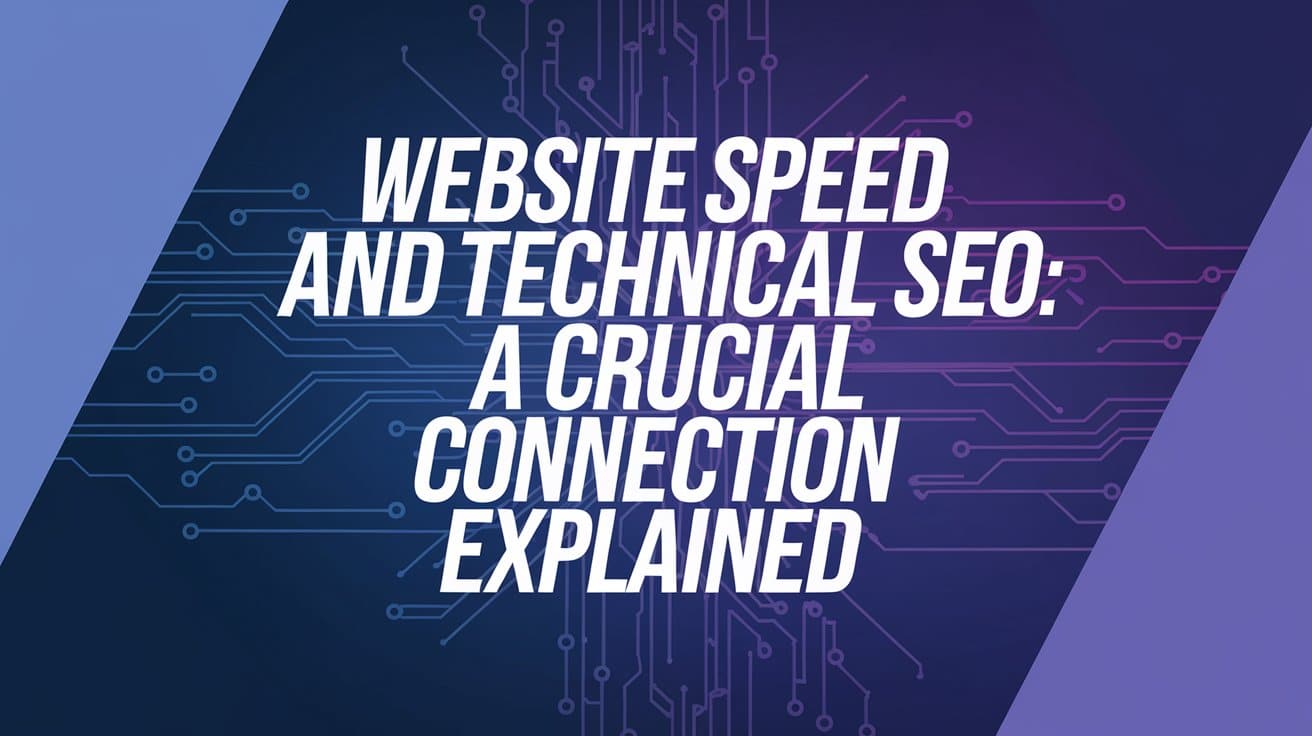Website speed and technical SEO are two crucial components of website optimization that are often overlooked. In today’s fast-paced digital world, users expect websites to load quickly and seamlessly, and search engines like Google consider website speed as one of the critical ranking factors. Therefore, having a fast-loading website is essential for both user experience and search engine optimization.
Technical SEO involves optimizing a website’s technical aspects to improve its visibility and ranking in search engines. It includes optimizing the website’s structure, code, and content to make it more accessible to search engines. Technical SEO also involves improving website speed, which is one of the most important ranking factors for search engines. A slow website not only affects user experience but also negatively impacts a website’s search engine ranking.
In this article, we will explore the crucial connection between website speed and technical SEO. We will discuss why website speed is essential for search engine optimization and user experience, how to measure website speed, and what technical SEO techniques can improve website speed. By the end of this article, readers will have a better understanding of the importance of website speed and technical SEO and how to optimize their website for both.
Understanding Website Speed and SEO
Website speed is a crucial factor in determining the success of a website. It is the amount of time it takes for a website to load its content. In today’s fast-paced world, users expect websites to load quickly, and if they don’t, they will quickly move on to another website. Slow website speed can lead to high bounce rates, low engagement, and ultimately, poor search engine rankings.
Search engines, particularly Google, have made website speed a ranking factor. This means that websites that load faster are more likely to rank higher in search engine results pages (SERPs). Google has been very clear about its expectations for website speed, stating that pages should load in under three seconds on both desktop and mobile devices.
Improving website speed can be achieved through a variety of means, including optimizing images, reducing server response time, and minimizing the use of plugins. It is important to note that website speed is not just about the server response time, but also about the time it takes for the browser to render the page.
In addition to improving user experience, website speed also has a significant impact on SEO. Faster websites are more likely to be crawled and indexed by search engines, which means that they are more likely to appear in search results. Slow websites, on the other hand, may be penalized by search engines, which can lead to lower rankings and less traffic.
Overall, understanding the connection between website speed and SEO is crucial for website owners and digital marketers. By improving website speed, they can improve user experience, increase engagement, and ultimately, boost their search engine rankings.
The Importance of Website Speed
Website speed is a crucial factor in providing a positive user experience. When a website loads quickly, users are more likely to stay and engage with the content. Conversely, if a website takes too long to load, users are likely to become frustrated and leave the site. This can lead to high bounce rates and low conversion rates, which can negatively impact a website’s search engine rankings.
Page speed and load time are two key factors that impact website speed. Page speed refers to how quickly a web page loads, while load time refers to the time it takes for a web page to fully load, including all images, videos, and other elements.
There are many reasons why website speed is important. For one, it can impact a website’s search engine rankings. Google has stated that page speed is a ranking factor, meaning that websites that load quickly are more likely to rank higher in search engine results pages (SERPs).
In addition to improving search engine rankings, website speed can also improve user experience. Users are more likely to engage with a website that loads quickly, which can lead to higher conversion rates. This is particularly important for e-commerce websites, where even a small increase in conversion rates can lead to a significant increase in revenue.
To improve website speed, there are several best practices that website owners should follow. These include optimizing images and other media, minimizing the use of plugins and other third-party scripts, and using a content delivery network (CDN) to reduce server response times.
Overall, website speed is a crucial factor in providing a positive user experience and improving search engine rankings. By following best practices for improving website speed, website owners can create a fast and responsive website that engages users and drives conversions.
Technical SEO and Its Connection to Website Speed
Technical SEO is a crucial aspect of website optimization that focuses on the technical elements of a website to improve its visibility and ranking on search engines. One of the key components of technical SEO is website speed. In fact, website speed is an important factor in Google’s ranking algorithm, which means that a slow website can negatively impact a website’s search engine ranking.
Website speed refers to how quickly a website loads and responds to user requests. It is affected by various technical factors such as server response time, image optimization, caching, and code optimization. A slow website can lead to a poor user experience, high bounce rates, and decreased engagement.
In order to improve website speed, technical SEO experts use various techniques such as optimizing images, minifying code, reducing server response time, and leveraging browser caching. These techniques help to reduce the size of web pages, improve server response times, and enable faster loading times.
Improving website speed not only enhances user experience but also helps search engine bots to crawl and index web pages more efficiently. A faster website ensures that search engine bots can crawl more pages in a shorter amount of time, which can lead to better indexing and higher search engine ranking.
In conclusion, technical SEO and website speed are closely interconnected. A fast website is crucial for both user experience and search engine ranking. Technical SEO experts should focus on optimizing website speed as part of their overall optimization strategy to ensure that their website is performing at its best.
Website Speed as a Ranking Factor
Website speed is a crucial ranking factor for search engines, including Google. The faster a website loads, the higher it will rank in search results. This is because faster loading websites provide a better user experience, which is a top priority for search engines.
A slow website can negatively impact organic traffic and search engine rankings. Research has shown that websites with longer loading times have a higher bounce rate, meaning that visitors are more likely to leave the website before it has fully loaded. This can lead to lower engagement metrics and a decrease in overall organic traffic.
Google has also confirmed that website speed is a ranking factor for both desktop and mobile search results. In addition, Google has introduced the Core Web Vitals metrics, which focus on user experience and include website speed as a key factor.
To improve website speed, technical SEO techniques such as optimizing images, reducing file sizes, and minimizing HTTP requests can be implemented. In addition, using a content delivery network (CDN) and optimizing server response times can also improve website speed.
Overall, website speed is a crucial ranking factor for search engines, and optimizing website speed should be a top priority for website owners and SEO professionals. By improving website speed, websites can achieve higher rankings, increased organic traffic, and improved user engagement.
Optimising Website Speed
Website speed is one of the most important factors that determines the success of a website. Slow loading pages can turn visitors away, resulting in a higher bounce rate and lower search engine rankings. Optimising website speed is crucial for improving user experience and increasing engagement.
One of the key factors that affects website speed is page speed optimization. This involves reducing the time it takes for a page to load by optimizing the website code, reducing the number of HTTP requests, and minimizing the size of files. A faster loading website can improve user experience, reduce bounce rates, and increase conversions.
Another way to improve website speed is by compressing images. Large images can slow down a website, so it’s important to optimize them for the web. Compressing images reduces their file size without compromising their quality, resulting in faster loading pages.
Using a content delivery network (CDN) is another way to improve website speed. A CDN is a network of servers that are located in different parts of the world. When a user visits a website, the CDN delivers the content from the server that is closest to them, reducing the time it takes for the content to load.
Finally, the server on which the website is hosted can also affect website speed. Choosing a reliable hosting provider with fast servers can improve website speed and reduce downtime. It’s also important to regularly monitor website speed and make improvements where necessary.
Technical SEO Elements Impacting Website Speed
Website speed is a crucial aspect of technical SEO. A fast website not only improves user experience but also helps in boosting search engine rankings. There are various technical SEO elements that impact website speed.
HTML
HTML is the foundation of any website. The way HTML is structured can have a significant impact on website speed. Bloated HTML code, unnecessary comments, and white spaces can slow down a website. Optimizing HTML code by removing unnecessary elements can help in improving website speed.
CSS
CSS is used to style HTML elements. The size and complexity of CSS files can impact website speed. Bloated CSS code, unnecessary comments, and white spaces can slow down a website. Optimizing CSS code by removing unnecessary elements and consolidating multiple CSS files can help in improving website speed.
JavaScript
JavaScript is used to add interactivity to a website. However, the size and complexity of JavaScript files can impact website speed. Bloated JavaScript code, unnecessary comments, and white spaces can slow down a website. Optimizing JavaScript code by removing unnecessary elements and consolidating multiple JavaScript files can help in improving website speed.
Images
Images are an essential part of any website. However, large images can significantly impact website speed. Optimizing images by compressing them and reducing their file size can help in improving website speed.
Redirects
Redirects are used to redirect users from one URL to another. However, too many redirects can impact website speed. Optimizing redirects by reducing their number can help in improving website speed.
HTTPS and SSL
HTTPS and SSL are used to secure a website. However, they can impact website speed. SSL certificates can take time to validate, which can cause a delay in website loading. Optimizing HTTPS and SSL by using a reliable SSL certificate and reducing the number of HTTPS requests can help in improving website speed.
In conclusion, technical SEO elements play a crucial role in impacting website speed. Optimizing HTML, CSS, JavaScript, images, redirects, HTTPS, and SSL can help in improving website speed and boosting search engine rankings.
Tools for Analysing and Improving Website Speed
Website speed is a crucial factor in technical SEO. A fast-loading website can improve user experience, increase engagement, and ultimately lead to higher conversions. There are several tools available to analyse and improve website speed.
One of the most popular tools is Google PageSpeed Insights. This tool analyses the content of a web page and generates suggestions to make that page faster. It provides a score out of 100 for both mobile and desktop versions of the page. The tool also highlights areas where improvements can be made, such as image optimisation and server response time.
Another tool worth considering is WebPageTest.org. This tool provides a detailed breakdown of a web page’s loading time, including a waterfall diagram of all resources loaded on the page. It also provides a performance review, which includes a grade for various performance metrics such as time to first byte and compress images.
Screaming Frog is a website crawler that can identify issues with a website’s speed and performance. It can crawl a website and provide a report on elements such as server response time, page size, and the number of requests made. This tool can help identify areas for improvement and provide a starting point for optimisation efforts.
In addition to these tools, it is also important to monitor website speed regularly to ensure that any changes made are having a positive impact. By using these tools, website owners can identify and fix issues that may be slowing their site down, ultimately leading to a better user experience and improved SEO.
Mobile Optimisation and Website Speed
Mobile optimisation is essential for websites in today’s digital age. With more and more users browsing the internet on their mobile devices, it is crucial for websites to be mobile-friendly. A mobile-friendly website is one that has been designed and optimised for use on mobile devices, such as smartphones and tablets.
One of the key factors in mobile optimisation is website speed. A fast-loading website is essential for providing a good user experience, and it is also an important factor in search engine optimisation (SEO). Google has stated that website speed is a ranking factor in its search algorithm, and slow-loading websites may be penalised in search results.
To ensure that a website is mobile-friendly and fast-loading, responsive design is often used. Responsive design is a design approach that allows a website to adapt to different screen sizes and resolutions. This means that the website will look and function correctly on any device, whether it is a desktop computer, a tablet, or a smartphone.
Mobile-first indexing is another important aspect of mobile optimisation. With mobile-first indexing, Google now uses the mobile version of a website as the primary version for indexing and ranking in search results. This means that it is even more important for websites to be mobile-friendly and fast-loading.
In summary, mobile optimisation and website speed are crucially connected. To ensure a good user experience and good search engine rankings, websites must be mobile-friendly, fast-loading, and designed with responsive design in mind.
Conclusion
In conclusion, website speed and technical SEO are crucially connected. A slow website can negatively impact user experience, search engine rankings, and ultimately, the success of a marketing strategy. Therefore, it is important to take actionable steps to ensure that a website is thoroughly optimized for speed and technical SEO.
One way to improve website speed is by optimizing images. Images can be compressed to reduce their file size, which can significantly improve website load times. Additionally, using a content delivery network (CDN) can help reduce server response times by caching content and serving it from a server closer to the user.
Technical SEO is also an important aspect of website optimization. Ensuring that a website has a clear hierarchy, optimized meta tags, and a sitemap can help search engines understand the content and structure of the website. This can improve the website’s authority and ranking in search engine results.
Overall, it is important to take a thorough approach to website optimization, considering both website speed and technical SEO. By doing so, a website can improve its user experience, search engine rankings, and ultimately, the success of a marketing strategy.







